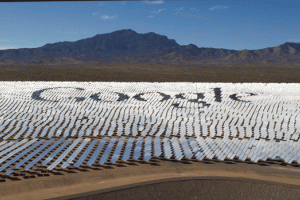October 17, 2016
Nearly half of the Fortune 500 companies, including Apple, Facebook, General Motors, Google, Target, and Wal-Mart, have announced sustainability and/or clean energy targets. Non-utility customers accounted for 52 percent of last year’s 4,000 megawatts of US wind deals, and US companies represented 907 megawatts of solar in 2015—a nearly 60 percent increase over the previous year.
However, procurement strategy isn’t evolving with the rate of adoption. The private sector’s attachment to the long-term power-purchase agreement (PPA) threatens the reputation of the renewables sector.
The sales pitch made by renewables project developers pushing long-term PPAs: wholesale energy costs will continue to rise, and consumers ought to lock in their energy rate for ten to twenty years with a PPA. The argument presented by the sales pitch contradicts the trend that has been observed over the previous seven years. Cheap natural gas is likely to sustain downward pressure on wholesale electricity prices for years to come. These depressed prices will be exacerbated by the coming wave of low-cost renewables. However, corporate consumers have not taken heed—about 75 percent of all wind capacity contracted via PPAs in the fourth quarter of 2015 will flow to companies.
A 3Degrees executive acknowledged the fallibility of the wholesale-pricing assumption, but ultimately defended the long-term PPA as a hedge and a cost-saving mechanism. While this rationale may resonate in the marketing department, it’s unlikely to win over finance and accounting. A long-term PPA is not a hedge. An actual hedge serves to reduce risk. A PPA merely fixes risk at an exorbitant premium.
The celebrated deal between Amazon Web Services and Dominion Virginia Power is a relevant case study. Renewable supply for Amazon’s data centers was acquired via long-term PPA. Dominion customized a retail adder that follows the projects’ wholesale pricing in PJM. A retail adder is a dollar amount assessed by the retailer to the energy consumed by the customer at the locational marginal price, such as an amount assessed atop the real-time energy rate for customers on a product with real-time exposure. The retail adder fluctuates so that when it is summed with the fixed PPA rate and variable wholesale price, the resulting all-in energy rate is always the same.
This means that if wholesale prices go up, Amazon is unable to capitalize on having locked in a lower energy rate via their PPA. Amazon will be stuck consuming at the agreed all-in energy rate. If wholesale prices trend downward, never exceeding the PPA rate, Amazon is locked into that same, immobile premium. There is no upside potential—only fixed risk.
Clean energy can be leveraged for more than predictability. The strategies outlined below for on-site and virtual resources can transform renewables into flexible risk mitigation instruments.
Hedge the grid
While the fuel component of a utility bill has plateaued, the price of energy delivery, controlled for inflation, is increasing. A company can hedge transmission and distribution (T&D) charges only by consuming less or generating behind the meter.
On-site solar is a particularly compelling solution for customers seeking to reduce coincident peak (CP) charges. The “shape” of solar generation naturally complements most customers’ consumption patterns during these CP intervals. Additionally, electricity market changes to CP months are unlikely to adversely impact the availability of solar during CP intervals. The same cannot be said for diesel- and gas-powered distributed generation, the value of which is more susceptible to CP program design changes.
Evaluation of T&D benefits requires interval-level historic usage, access to forward market curves at the interval level, estimated project output by season, and a market-specific understanding of how T&D charges are assessed to load. Holistic modeling requires access to information that a project developer does not have, so it’s up to the customer (or their retailer or broker) to amass the data and ascertain the value of on-site generation.
Align retail contract with renewables production
A company with a virtual PPA may unknowingly buy power twice unless it fits its retail electricity contract to renewable energy production.
Take, for example, a company with a wind offtake, or a company that buys generation in real-time from a specific facility: It buys the wind generation at the costly PPA rate but must liquidate the generation at the locational marginal price (LMP)—the cheaper real-time rate. The company compounds this loss by buying the power a second time in the form of the conventional retail electricity delivered to its facility. The company is hedged only if the LMP for its wind output minus its PPA rate (seldom a positive figure) is equal to or greater than its retail electricity rate at the time it happens to be consuming power at its facility. Wind output typically represents an inverse relationship to load, so these stars are difficult to align.
Instead, the company ought to ensure that estimated interval production from the renewables asset is incorporated into the load forecast, or amount of energy a given facility is likely to consumer over a given contract term, at the time its retail contract is priced. This is not as easy as it sounds. A company’s traditional energy procurement team frequently operates independently of the sustainability group executing the renewables contracts, consequently hindering internal coordination—especially when there are multiple operating companies and facilities involved.
A retailer with the market certification to schedule generation to the customer can more accurately synchronize the company’s renewables offtake with traditional supply. As long as the company has contracted the renewable generation at a volume below its facility’s baseload, this strategy can alleviate the double-purchase effect.
At the very least, a company constrained to a traditional offtake agreement ought to pursue community renewables projects that afford it the ability to lock in a fixed rate over a shorter term—typically five years or less.
Renewables are worth more than a positive image of the company, but clean energy advocates have struggled to quantify the value. The formula isn’t readily standardized. Few brokers, utilities or retail providers have the expertise or the data to perform this highly localized cost-benefit assessment.
However, corporate consumers wield unique influence, and they ought to pressure these stakeholders for sophisticated solutions. Even firms for which energy is a principal cost input may be surprised to learn that it’s possible to achieve sustainability without sacrificing profitability.
Clare Magee is an Emerging Leaders in Environmental and Energy Policy (ELEEP) fellow with the Atlantic Council and Ecologic Institute.
*This publication originally appeared on the Atlantic Council's New Atlanticist Blog and on Greentech Media (GTM).
Photo: Steve Marcus, Reuters
Location:
Berlin
Publication Type:






